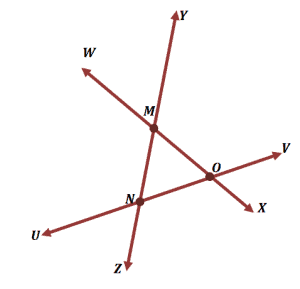What Makes Intersecting Lines Different from Concurrent Lines?
FAQs on Understanding the Difference Between Intersecting and Concurrent Lines
1. What is the difference between intersecting lines and concurrent lines?
Intersecting lines are lines that cross at a single point, while concurrent lines are three or more lines that all meet at the same point.
Key differences:
- Intersecting lines involve only two lines meeting at one point.
- Concurrent lines include three or more lines passing through a common point called the point of concurrency.
- All concurrent lines are intersecting, but not all intersecting lines are concurrent.
2. Define intersecting lines with an example.
Intersecting lines are two lines that meet or cross each other at one common point.
Example:
- If line AB and line CD cross at point P, then AB and CD are intersecting lines.
- They form an angle at the point of intersection.
3. What are concurrent lines with an example?
Concurrent lines are three or more lines that all pass through a single point.
Example:
- If lines l, m, and n all meet at point O, they are concurrent lines, and O is their point of concurrency.
4. Can two lines be concurrent?
No, two lines that meet are called intersecting lines. The term concurrent lines specifically refers to three or more lines passing through a single point.
5. Is every set of intersecting lines also concurrent lines?
No, not every set of intersecting lines is concurrent. Two lines that intersect are just intersecting, while concurrent lines require at least three lines meeting at one point.
6. What is the point of concurrency?
Point of concurrency is the single point where three or more concurrent lines intersect.
Example:
- In a triangle, the medians meet at a point called the centroid — the point of concurrency.
7. How do you identify intersecting lines on a graph?
To identify intersecting lines on a graph, look for two lines that cross each other at exactly one point. Their point of intersection is where they meet on the graph.
8. List real-life examples of intersecting and concurrent lines.
Real-life examples:
- Intersecting lines: The crossing of two roads at a junction.
- Concurrent lines: The hands of a clock at 12 o'clock (all meet at the center, the point of concurrency).
9. Why are concurrent lines important in geometry?
Concurrent lines are important in geometry because they help locate special points like the centroid, incenter, circumcenter, and orthocenter of triangles. These points have important properties used in geometric constructions.
10. What are the properties of concurrent lines?
Properties of concurrent lines:
- Three or more lines meet at a single point (point of concurrency).
- The point is unique for a given set of lines.
- Concurrent lines are used to define important geometric locations in triangles and other figures.
11. Can parallel lines be concurrent or intersecting?
No, parallel lines are neither intersecting nor concurrent because they never meet at any point, no matter how far they are extended.
12. How do you prove that three lines are concurrent?
To prove that three lines are concurrent, show that they all pass through a common point.
Steps:
- Find the intersection of two lines first.
- Check if the third line passes through that intersection point.
- If all three go through the same point, the lines are concurrent.


























